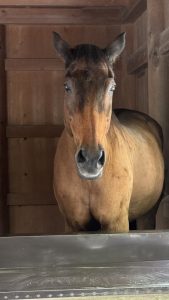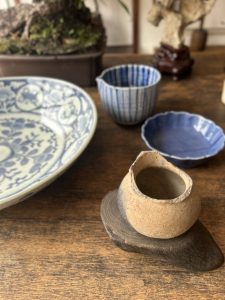室町時代から奉納されている絵馬(愛知県名古屋市千種区姫池通 骨董買取 古美術風光舎)
2025.07.02
ここのところ、査定でお伺いさせていただくお宅でよく耳にするお話があります。
「茶道具など価値が分からない品物を既に処分してしまった。」「掛軸を処分する前に査定だけでもしてもらえばよかった」などのお声です。
お片付けが大変になってくると考えることにも疲れ、とりあえず物を減らしたいという気持ちになるのは当然のことでしょう。しかし処分されてしまうには勿体ないお品物もあるかもしれません。お片付けの途中でも構いませんので、処分なさる前に一声かけていただけると幸いです。無料で査定させていただきます。
さて、 先日伊勢神宮に参拝した家族から「神馬(しんめ)」の写真が送られてきました。私も何度も参拝している伊勢神宮ですが神馬に会えたことがありません。毎月1日、11日、21日の早朝8時頃に神馬が正宮に参拝する儀式が行われることは知っていましたが、早朝8時頃と聞いていたのでまずお目にかかることはないだろうと思っておりました。

伊勢神宮では奈良時代から朝廷による馬の奉納が行われています。中断した時期もあったようですが、明治2年より神馬が天寿を全うすると皇室から新しく馬が奉納されることになっているようです。
内宮では御厩(みうまや)に神馬がいることはあまりなく、会えるとラッキーだとされています。今回家族が会えたのは2018年6月に奉納された「草新号(くさしんごう)」。伊勢神宮に来るまでは宮内庁において「打球」や外交団乗馬の馬として活躍していたようです。
あまりにもカメラ目線なので不謹慎にも笑いそうになってしまいましたが、ずっと見ていると写真にも関わらず何かを見透かされているような気持ちにもなります。
古代の日本で馬は「神様の乗り物」であり神聖な動物とされてきたため、雨乞いや五穀豊穣などの願掛けや、その願いが叶った感謝のしるしとして神前に奉納されてきました。しかし高価な馬を奉納し続けるのが難しくなり、馬のかわりに「馬の絵」を描いた板を奉納するようになっていきます。これが現在の「絵馬」につながっているといいます。
現在では変わり種の絵馬も色々と登場しているようですが、名古屋の熱田神宮でも通常の形の絵馬の他に、白鳥が描かれた星形の絵馬があります。白鳥は熱田神宮に祀られる神様のひとり、日本武尊(やまとたけるのみこと)が亡くなった後に白鳥になって妻の宮簀姫命のもとへ帰ってきたという伝説にちなんだものだそうです。そのため縁結びのご利益もあるとされています。星形の絵馬は昔はなかったような気がして調べてみますと、やはり2019年頃に登場したのだとか。
絵馬といえばで今でも強烈に目に焼き付いている光景があります。京都の石像寺に室町時代より奉納されている絵馬です。空海によって創設されたと伝えられている石像寺は通称を釘抜地蔵(くぎぬきじぞう)とも呼ばれ、人々の体の痛みや心の苦しみとなっている釘を抜いてくれるという地蔵菩薩が祀られています。
ふらっと入ったお寺だったのですが、本堂をみて驚きました。お堂の外壁にぐるりと約1000枚の絵馬が一面に貼り付けられているのですが、その絵馬のひとつひとつに実物の八寸釘二本と釘抜きが針金で留められています。体や心の苦しみが癒えた人がお礼参りで納めたものだそうです。
お参りの方法は、本堂の周りを自分の数え年の数だけ回ります。回るうちに忘れてしまうのではと私のように心配になった方、ご安心ください。お堂の横の木箱に木の棒があり年の数だけ手に持ち、一周することに一本ずつ木箱に返していきます。年齢が高いほど持つのが大変になりますが…。
その時の願いは叶いましたが、御礼参りに行っていないことに気づき心苦しくなってまいりました。
釘抜地蔵の写真を探しましたが見つけられず…ご興味のある方はぜひ検索してみてください。
それでは、また次の機会に。(スタッフH)

Recently, there is a story that we often hear at the houses we visit for appraisal.
They say, “I have already disposed of tea ceremony utensils and other items whose value I don’t know. We are tired of thinking about how hard it is to clean out the house, and we want to reduce the number of things we have for now.
It is natural that when cleaning up becomes difficult, people get tired of thinking about it and want to reduce the number of things they have. However, there may be items that are too good to be disposed of. We would be happy to hear from you even if you are in the middle of cleaning up, so please contact us before disposing of your items. We would be happy to evaluate your items free of charge.
The other day, I received a photo of “Shinme” from a family member who visited Ise Jingu Shrine. I have visited Ise Jingu Shrine many times, but I have never been able to see Shinme. I knew that on the 1st, 11th, and 21st of every month, a ceremony is held around 8:00 a.m., but I had heard that it was held around 8:00 a.m., so I thought I would not be able to see the shrine’s sacred horses.
The dedication of horses by the Imperial Court has been held at Ise Jingu since the Nara period (710-794). There was a time when this practice was discontinued, but since the 2nd year of Meiji (1869), a new horse has been dedicated by the imperial family when a sacred horse has reached the end of its natural life.
It is rare to see the sacred horses in the inner shrine stables, and it is considered lucky to be able to see them. The one the family was able to meet this time was Kusashin Go, dedicated in June 2018. Before coming to Ise Jingu, he had been active at the Imperial Household Agency as a “battalion” or diplomatic corps riding horse.
I almost laughed because of the way he was looking at the camera, but the longer I looked at him, the more I felt as if I could see right through him, despite the fact that he was a photograph.
In ancient Japan, horses were considered sacred animals and “vehicles of the gods,” so they were dedicated to the gods to pray for rain or a good harvest, or as a sign of gratitude for the fulfillment of such wishes. However, it became difficult to continue to dedicate expensive horses, and instead of horses, people began to dedicate boards on which “pictures of horses” were drawn. This is said to have led to today’s “ema” (votive tablet with a picture of a horse).
Today, various types of ema have appeared. At Atsuta Jingu Shrine in Nagoya, there is a star-shaped ema with a picture of a swan on it, in addition to the regular type of ema. The swan is said to be associated with the legend that one of the deities enshrined at Atsuta Jingu, Yamatotakeru no Mikoto, turned into a swan after his death and returned to his wife Miyasumihimenomikoto. It is said to be a good luck charm for matchmaking. I felt that ema (votive tablet) in the shape of a star did not exist in the past, so I looked it up and found that it was introduced around 2019.
Speaking of ema, there is a scene that is still burned into my mind’s eye. It is an ema that has been dedicated to Ishizouji Temple in Kyoto since the Muromachi period (1333-1573). Ishizouji Temple, founded by Kukai, is also known as Kuginuki Jizo, and is dedicated to the Jizo Bodhisattva, who is believed to remove nails that cause people physical pain and mental suffering.
I entered the temple on a whim and was surprised to see the main hall. There are about 1,000 ema (votive picture tablets) pasted all over the outer wall of the hall, and on each one of them are two actual 8-sun nails and a nail puller attached with a wire. It is said that these ema are used by people who have been healed of their physical and mental suffering and who pay their respects to the temple.
The way to visit the shrine is to go around the main hall as many times as your numbered years. If you are worried, as I was, that you will forget your year as you go around the hall, don’t worry. There is a wooden box next to the hall with wooden sticks, which you hold in your hand for the number of years you are in the same year, and return one stick at a time to the box after each round of the hall. The older you are, the harder it is to hold….
My wish was granted at that time, but I realized that I had not visited the shrine to express my gratitude.
I looked for a photo of the Nugidan Jizo, but could not find it. If you are interested, please search for it.
See you next time. (Staff H)
*****************
ご実家の整理やお片付けなどをされている方のご相談などが多くございます。
お片付けなどくれぐれもご無理のないようになさってくださいませ。
風光舎では古美術品や骨董品の他にも絵画や宝石、趣味のお品など様々なジャンルのものを買受しております。
お片付けをされていて、こういうものでもいいのかしらと迷われているものでも、どうぞお気軽にご相談下さいませ。
また風光舎は、出張買取も強化しております。ご近所はもちろん、愛知県内、岐阜県、三重県その他の県へも出張いたします。
まずは、お電話お待ちしております。
愛知県名古屋市千種区姫池通
骨董 買取【古美術 風光舎 名古屋店】
TEL052(734)8444
10:00-18:00 OPEN

